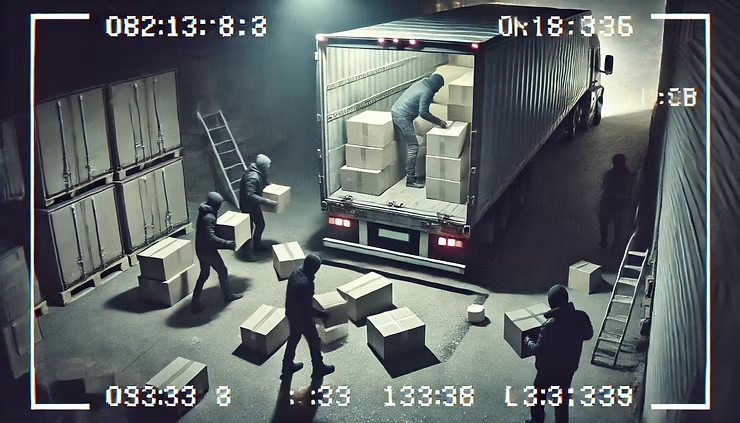Cargo theft is on the rise, costing billions each year. Discover how Convoy Technologies' advanced camera systems deter and prevent theft with real-time monitoring, GPS integration, and more. Learn effective cargo theft prevention strategies today.
Cargo theft costs the U.S. economy an estimated $15 billion to $35 billion annually (National Insurance Crime Bureau). With theft tactics becoming more sophisticated, protecting fleet vehicles and valuable cargo has never been more crucial. In this post, we explore the latest cargo theft trends, common theft methods, and how Convoy Technologies’ advanced camera systems offer effective solutions to safeguard against theft.

Understanding Cargo Theft Trends
In the first half of 2024, North America experienced a 49% surge in cargo theft incidents compared to the same period in 2023. California accounted for nearly half of all incidents, with a high concentration near the Ports of Los Angeles and Long Beach (Supply Chain Brain). However, cargo theft isn’t limited to the West Coast—states like Texas, Florida, and Illinois are also heavily impacted.
The most commonly targeted goods include:
- Food and Beverages: 21% of thefts
- Electronics: 10%
- Automotive Parts: 7%
- Fuel: 8% (TT Club)
Organized crime rings often employ tactics like identity theft, impersonating carriers to pick up cargo fraudulently, and GPS jamming devices to disrupt tracking (ShipLilly). As cargo theft becomes more prevalent, fleet managers must stay vigilant to protect high-value shipments.
Common Methods of Cargo Theft
Cargo theft usually happens in areas where trucks are left unattended, such as truck stops or dark parking lots. The main tactics include:
- Breaking into warehouses or storage areas to steal cargo directly.
- Taking entire trucks when they are parked overnight.
- Armed criminals may intercept and take control of trucks mid-route.
- Thieves impersonate legitimate carriers to fraudulently pick up cargo (TT Club).
How Convoy Technologies’ Cameras Help Prevent Cargo Theft
Preventing cargo theft requires vigilance, planning, and the right technology. Cameras are among the most effective deterrents for protecting both cargo and fleet vehicles. Here’s how Convoy Technologies’ cameras provide a comprehensive solution:
Visible cameras alone act as a powerful deterrent, making thieves less likely to target a vehicle with surveillance equipment. Convoy’s advanced cameras provide real-time monitoring, allowing fleet managers to track shipments even while they’re on the road. Knowing that their actions are recorded is often enough to deter would-be thieves (National Insurance Crime Bureau).
In the unfortunate event of a theft, Convoy Technologies’ cameras capture critical details, such as license plate numbers, facial images, and other identifiers. This data helps law enforcement track down stolen goods and apprehend criminals. Convoy’s camera systems are designed for trucking fleets, providing clear footage in all weather conditions (Supply Chain Brain).
Convoy’s cameras integrate seamlessly with GPS and telematics systems, enabling fleet managers to monitor vehicle locations and track routes. Coupled with RFID tags on high-value items, this setup ensures that shipments remain secure and provides crucial tracking data in case of suspicious activity (ShipLilly).
Some cameras are configured to start recording upon detecting specific triggers, like door openings or unexpected movements. This setup is ideal for catching thieves in the act, especially when trucks are left unattended or parked in high-risk areas (TT Club).
Do Fleet Vehicles Have Cameras in Them?
Yes, most commercial fleets now use onboard cameras to improve driver safety, reduce liability, and protect cargo. From backup cameras and side views to complete in-cab displays, these systems offer critical visibility. Many companies install rear view camera systems for trucks as part of their fleet security strategy.
Fleet managers often rely on aftermarket camera systems to retrofit older vehicles, bringing them up to modern safety standards without the need for full replacement. Our solutions are designed for both new and existing commercial fleets, ensuring wide coverage and integration with fleet telematics for real-time fleet monitoring.
Additional Strategies to Bolster Security
While cameras are a powerful tool, they work best alongside other preventative measures:
- Conduct Regular IT Audits: Identity theft tactics often involve hacking freight companies' systems to gain access to pickup details. Routine IT audits and employee training can help secure data and prevent phishing scams (ShipLilly).
- Implement Secure Parking Practices: Plan routes that allow for well-lit, secure parking areas, minimizing the chance of theft while vehicles are unattended.
- Improve Communication with Clients: Keep clients informed of pickup details, including driver information and vehicle ID, to ensure only authorized personnel access goods (TT Club).
- Enhance Employee Training and Vetting: Comprehensive vetting and training can prevent internal theft and help employees recognize threats.
Do Semi Truck Cameras Record All the Time?
Yes, most semi truck camera systems are designed for continuous operation or event-based recording. Many fleet vehicles are equipped with surveillance that captures video 24/7 or automatically when a specific event is triggered. Such as a hard brake, collision, or intrusion.
Convoy Technologies provides camera systems that can operate in both modes, giving fleet managers flexibility. These systems often include rear view camera coverage, side angles, and cabin-facing lenses, ensuring a full view of the vehicle’s surroundings. Combined with GPS tracking, they also offer timestamped evidence and continuous data collection. This is critical for investigations, insurance claims, or performance reviews.
Cameras: Your Best Defense Against Cargo Theft
Theft tactics are more advanced than ever, camera technology stands out as a top defense. Our cameras not only deter theft but also offer peace of mind and valuable evidence for insurance claims or law enforcement. The visibility, monitoring capabilities, and deterrent value of cameras make them indispensable for fleet managers committed to securing their cargo and maintaining reliability.
By combining Convoy’s camera systems with strategic planning and best practices, you can build a robust security network that helps prevent theft and protects your business from the costly impact of cargo loss.
Frequently Asked Questions (FAQ)
- How do cameras help prevent cargo theft? Cameras provide real-time monitoring and capture crucial details in the event of theft, helping to deter criminal activity and assisting law enforcement in recovery efforts.
- What makes Convoy Technologies’ cameras effective for fleet security? Convoy’s cameras integrate with GPS and telematics for enhanced tracking and monitoring. They provide high-quality footage even in adverse conditions, making them ideal for fleet security.
- Where are the most common locations for cargo theft? Cargo theft frequently occurs in areas where trucks are left unattended, such as truck stops and poorly lit parking lots. Major ports and high-freight areas are also common hotspots.
Sources
- National Insurance Crime Bureau. Cargo Theft Resource. Retrieved from nicb.org
- Supply Chain Brain. Cargo Thefts in North America Jump 49% in First Half of 2024. Retrieved from supplychainbrain.com
- TT Club. Cargo Theft Report April 2024. Retrieved from ttclub.com
- Ship Lilly. Rising Cargo Theft in 2024: Trends, Impacts, and Industry Responses. Retrieved from shiplilly.com
Ready to protect your fleet? Explore Convoy Technologies’ camera systems and discover how they can help prevent cargo theft. Contact us for a demo today!



